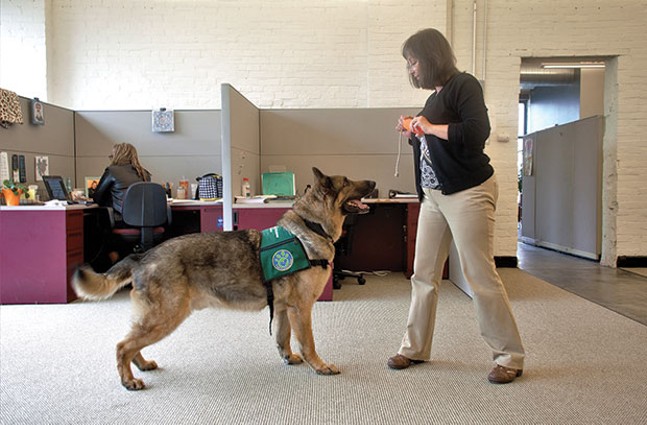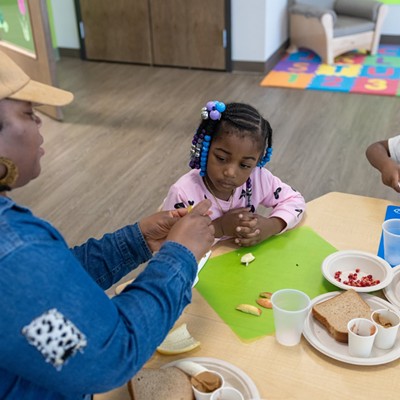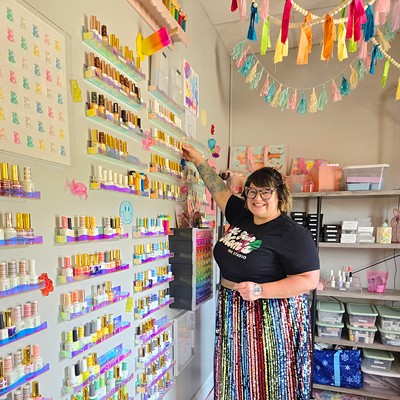Editor’s note: The name of the child in this story has been changed to protect her identity.
When 5-year-old Jamie first began attending therapy sessions at the Center for Victims, her therapist says, she suffered from low self-esteem and disobedience. Jamie had been sexually abused and had few coping skills to manage the emotional experiences she’d gone through.
“[Jamie] presented with trauma symptoms of hypervigilance, avoidance of use of language to describe thoughts, emotions and experiences,” says therapist Megan Cook. “She had little awareness of personal space for self or others, engaged in repetitive traumatic play in session with themes of self-blame, guilt, confusion and a general sense of being in and causing trouble.”
But then Jamie met Gryffin, a 10-year-old German shepherd serving as a “canine advocate” at the Center for Victims, a victim-services and advocacy organization. Jamie’s parents gave permission to include Gryffin in their daughter’s therapy session, and they quickly saw a change in her behavior.
“Having Gryffin available to her has had such a positive impact,” said Jamie’s mother. “He has helped her self-esteem so much.”
Gryffin is part of a new program launched in February at the Center for Victims and the Child Advocacy Center (CAC) at UPMC’s Children’s Hospital of Pittsburgh. The program is in partnership with Pups Providing Hope, a nonprofit aimed at providing service agencies and the courts with access to trained dogs and handlers in order to bring comfort to victims of violent crimes and other traumatic events.
The program, believed to be the only one of its kind in the country, is designed for canines to follow children and their families through the various processes involved in child-abuse cases, from the investigation into prosecution, and throughout trauma treatment. Gryffin began working with children in April.
“One of the things we wanted to do for Pennsylvania crime victims is expand our services to help people heal from the negative experiences they have,” says Tracey Provident, chief program officer at Center for Victims. “These dogs will stay with a child throughout the process they are enduring as victims of child abuse. Through all the systems they have to interact with, they will have that consistency.”
Children are introduced to Gryffin in the waiting room prior to a therapy session at Center for Victims or the forensic interview at the CAC. Potts checks to make sure the children don’t have any allergies that could be aggravated by interacting with Gryffin, and ensures the children aren’t afraid of dogs.
The children then walk Gryffin, learning how to clip and unclip his leash. They also learn how to give simple commands like “sit,” “shake” and “lie down.” After each session, the kids are allowed to play with Gryffin to release any built-up tension.
“It gives them focus. It gives them something to do and it calms them down,” says Tammi Potts, Gryffin’s owner and the canine-assisted advocate at the Center for Victims. “The dogs are so calm that when the kids are escalating up, the dog brings them back down. And if you have a child that’s not responding well, they don’t want to speak or interact, what we do is we use it as an ice-breaker and an empowerment tool for the kid.”
During the session, Gryffin serves as a source of comfort for the children. In forensic interviews, children are asked to recount the abuse they experienced. The interview can be traumatic.
“He’ll check in with the child every so often and if they need him, he’ll interact with them,” says Potts. “They can reach down and pet him. Sometimes they’ll get down and sit with him on the floor.”
Potts has been a dog trainer for more than two decades. She’s trained canines to be therapy dogs and work in nursing homes, but Gryffin’s training has been far more extensive.
To make a dog suitable for what we’re doing you need a dog who’s bomb-proof,” says Potts. “They have to be able to handle pretty much anything. I had a kid drop a bucket of crayons next to his head. You just don’t know what the children are going to do, so you have to be prepared for anything.”



















